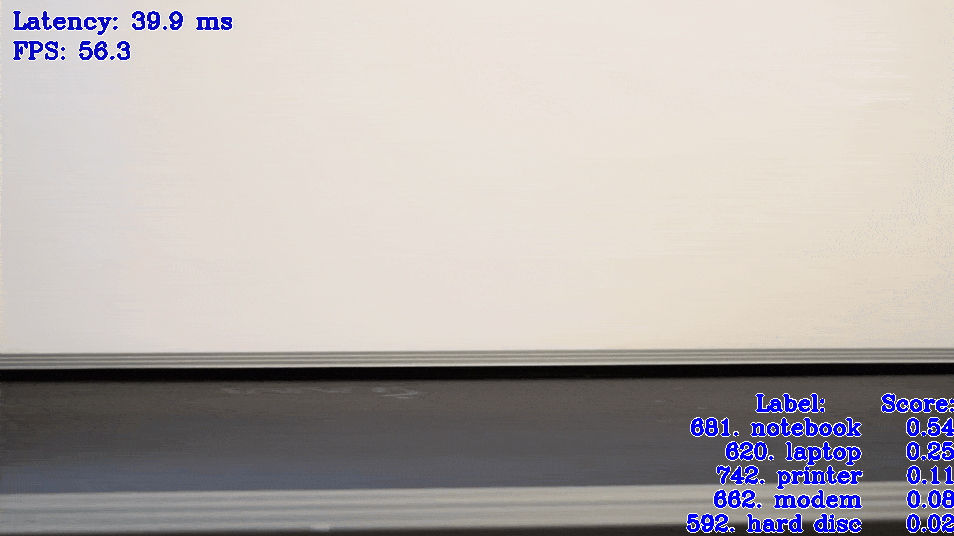Classification Python* Demo¶

This demo showcases inference of Classification networks using Python* Model API and Async Pipeline.
How It Works¶
On startup, the application reads command line parameters and loads a classification model to OpenVINO™ Runtime plugin for execution. Upon getting a frame from the OpenCV VideoCapture, it performs inference and displays the results.
You can stop the demo by pressing “Esc” or “Q” button. After that, the average metrics values will be printed to the console.
NOTE: By default, Open Model Zoo demos expect input with BGR channels order. If you trained your model to work with RGB order, you need to manually rearrange the default channels order in the demo application or reconvert your model using the Model Optimizer tool with the
--reverse_input_channelsargument specified. For more information about the argument, refer to When to Reverse Input Channels section of [Embedding Preprocessing Computation](@ref openvino_docs_MO_DG_Additional_Optimization_Use_Cases).
Model API¶
The demo utilizes model wrappers, adapters and pipelines from Python* Model API.
The generalized interface of wrappers with its unified results representation provides the support of multiple different classification model topologies in one demo.
Preparing to Run¶
The list of models supported by the demo is in <omz_dir>/demos/classification_demo/python/models.lst file.
This file can be used as a parameter for Model Downloader and Converter to download and, if necessary, convert models to OpenVINO IR format (*.xml + *.bin).
An example of using the Model Downloader:
omz_downloader --list models.lst
An example of using the Model Converter:
omz_converter --list models.lst
Supported Models¶
alexnet
caffenet
convnext-tiny
densenet-121
densenet-121-tf
dla-34
efficientnet-b0
efficientnet-b0-pytorch
efficientnet-v2-b0
efficientnet-v2-s
googlenet-v1
googlenet-v1-tf
googlenet-v2
googlenet-v2-tf
googlenet-v3
googlenet-v3-pytorch
googlenet-v4-tf
hbonet-0.25
hbonet-1.0
inception-resnet-v2-tf
levit-128s
mixnet-l
mobilenet-v1-0.25-128
mobilenet-v1-1.0-224
mobilenet-v1-1.0-224-tf
mobilenet-v2
mobilenet-v2-1.0-224
mobilenet-v2-1.4-224
mobilenet-v2-pytorch
mobilenet-v3-large-1.0-224-paddle
mobilenet-v3-large-1.0-224-tf
mobilenet-v3-small-1.0-224-paddle
mobilenet-v3-small-1.0-224-tf
nfnet-f0
octave-resnet-26-0.25
regnetx-3.2gf
repvgg-a0
repvgg-b1
repvgg-b3
resnest-50-pytorch
resnet-18-pytorch
resnet-34-pytorch
resnet-50-pytorch
resnet-50-tf
resnet18-xnor-binary-onnx-0001
resnet50-binary-0001
rexnet-v1-x1.0
se-inception
se-resnet-50
se-resnext-50
shufflenet-v2-x0.5
shufflenet-v2-x1.0
squeezenet1.0
squeezenet1.1
swin-tiny-patch4-window7-224
t2t-vit-14
vgg16
vgg19
NOTE: Refer to the tables Intel’s Pre-Trained Models Device Support and Public Pre-Trained Models Device Support for the details on models inference support at different devices.
Required Files¶
If you want to see classification results, you must use “-labels” flags to specify .txt file containing lists of classes and labels.
Please note that you should use <omz_dir>/data/dataset_classes/imagenet_2015.txt labels file with the following models:
googlenet-v2
se-inception
se-resnet-50
se-resnext-50
and <omz_dir>/data/dataset_classes/imagenet_2012.txt labels file with all other models supported by the demo.
Running¶
Running the application with the -h option yields the following usage message:
usage: classification_demo.py [-h] -m MODEL [--adapter {openvino,ovms}] -i INPUT [-d DEVICE] [--labels LABELS] [-topk {1,2,3,4,5,6,7,8,9,10}] [--layout LAYOUT] [-nireq NUM_INFER_REQUESTS] [-nstreams NUM_STREAMS] [-nthreads NUM_THREADS]
[--loop] [-o OUTPUT] [-limit OUTPUT_LIMIT] [--no_show] [--output_resolution OUTPUT_RESOLUTION] [-u UTILIZATION_MONITORS] [--reverse_input_channels] [--mean_values MEAN_VALUES MEAN_VALUES MEAN_VALUES]
[--scale_values SCALE_VALUES SCALE_VALUES SCALE_VALUES] [-r]
Options:
-h, --help Show this help message and exit.
-m MODEL, --model MODEL
Required. Path to an .xml file with a trained model or address of model inference service if using OVMS adapter.
--adapter {openvino,ovms}
Optional. Specify the model adapter. Default is openvino.
-i INPUT, --input INPUT
Required. An input to process. The input must be a single image, a folder of images, video file or camera id.
-d DEVICE, --device DEVICE
Optional. Specify a device to infer on (the list of available devices is shown below). Use '-d HETERO:<comma-separated_devices_list>' format to specify HETERO plugin. Use '-d MULTI:<comma-separated_devices_list>'
format to specify MULTI plugin. Default is CPU
Common model options:
--labels LABELS Optional. Labels mapping file.
-topk {1,2,3,4,5,6,7,8,9,10}
Optional. Number of top results. Default value is 5. Must be from 1 to 10.
--layout LAYOUT Optional. Model inputs layouts. Ex. NCHW or input0:NCHW,input1:NC in case of more than one input.
Inference options:
-nireq NUM_INFER_REQUESTS, --num_infer_requests NUM_INFER_REQUESTS
Optional. Number of infer requests
-nstreams NUM_STREAMS, --num_streams NUM_STREAMS
Optional. Number of streams to use for inference on the CPU or/and GPU in throughput mode (for HETERO and MULTI device cases use format <device1>:<nstreams1>,<device2>:<nstreams2> or just <nstreams>).
-nthreads NUM_THREADS, --num_threads NUM_THREADS
Optional. Number of threads to use for inference on CPU (including HETERO cases).
Input/output options:
--loop Optional. Enable reading the input in a loop.
-o OUTPUT, --output OUTPUT
Optional. Name of the output file(s) to save. Frames of odd width or height can be truncated. See https://github.com/opencv/opencv/pull/24086
-limit OUTPUT_LIMIT, --output_limit OUTPUT_LIMIT
Optional. Number of frames to store in output. If 0 is set, all frames are stored.
--no_show Optional. Don't show output.
--output_resolution OUTPUT_RESOLUTION
Optional. Specify the maximum output window resolution in (width x height) format. Example: 1280x720. Input frame size used by default.
-u UTILIZATION_MONITORS, --utilization_monitors UTILIZATION_MONITORS
Optional. List of monitors to show initially.
Input transform options:
--reverse_input_channels
Optional. Switch the input channels order from BGR to RGB.
--mean_values MEAN_VALUES MEAN_VALUES MEAN_VALUES
Optional. Normalize input by subtracting the mean values per channel. Example: 255.0 255.0 255.0
--scale_values SCALE_VALUES SCALE_VALUES SCALE_VALUES
Optional. Divide input by scale values per channel. Division is applied after mean values subtraction. Example: 255.0 255.0 255.0
Debug options:
-r, --raw_output_message
Optional. Output inference results raw values showing.
Running the application with the empty list of options yields an error message.
For example, use the following command-line command to run the application:
python3 classification_demo.py -m <path_to_classification_model> \
-i <path_to_folder_with_images> \
--labels <path_to_file_with_list_of_labels>
Running with OpenVINO Model Server¶
You can also run this demo with model served in OpenVINO Model Server. Refer to OVMSAdapter to learn about running demos with OVMS.
Exemplary command:
python3 classification_demo.py -m localhost:9000/models/classification \
-i <path_to_folder_with_images> \
--labels <path_to_file_with_list_of_labels> \
--adapter ovms
Demo Output¶
The demo uses OpenCV to display images with classification results presented as a text on them. The demo reports:
FPS: average rate of video frame processing (frames per second).
Latency: average time required to process one frame (from reading the frame to displaying the results).
Latency for each of the following pipeline stages:
Decoding — capturing input data.
Preprocessing — data preparation for inference.
Inference — infering input data (images) and getting a result.
Postrocessing — preparation inference result for output.
Rendering — generating output image.
You can use these metrics to measure application-level performance.